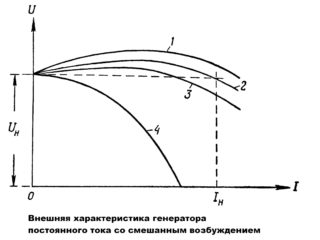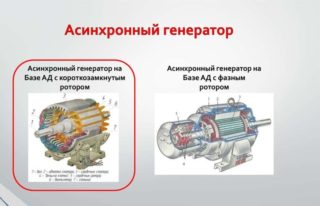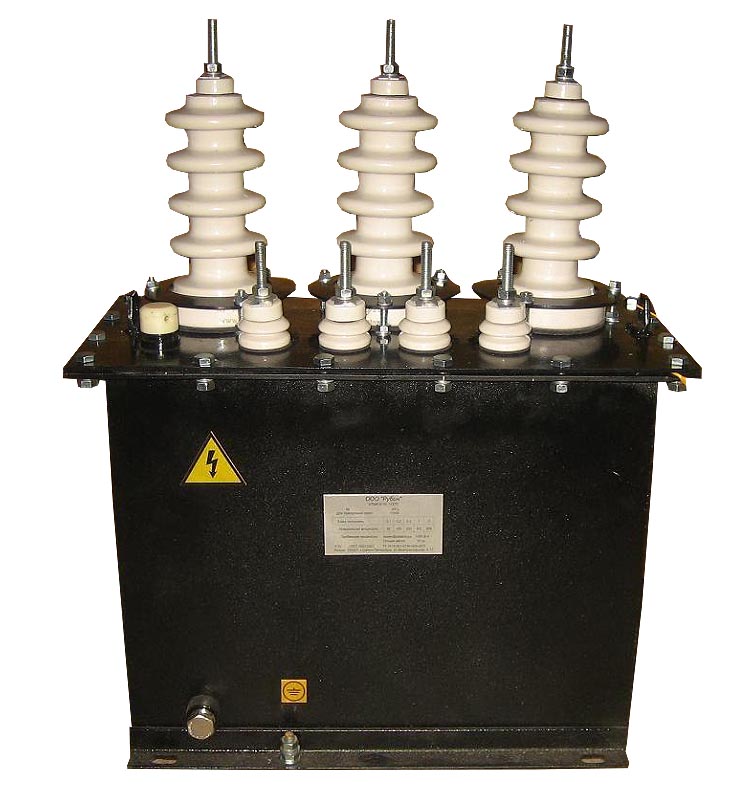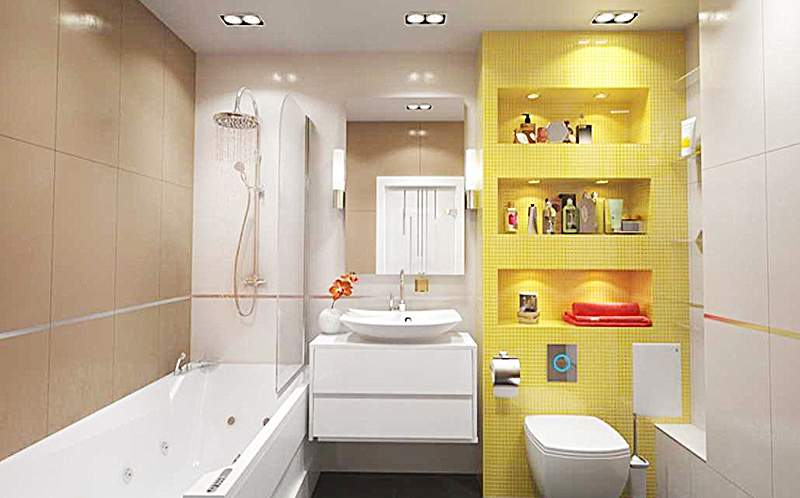An electric current generator is a device designed to convert non-electrical types of energy (chemical, mechanical, thermal) into electrical energy. Moreover, its design is based on the use of the principle of electromagnitic induction.
The principle of operation and the device of the simplest alternator
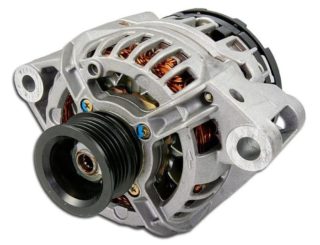
Electromagnetic induction is a phenomenon that was discovered in 1831 by the English physicist Michael Faraday (1791-1867), who discovered that when a time-varying magnetic flux passes through a closed conductive circuit, an electric current is generated in the latter. It is this principle that underlies any generator.
In practice, the principle of electromagnetic induction is implemented as follows: an electric current arises in a closed frame (rotor) when it is crossed by a rotating magnetic field formed, depending on the purpose and design of the generator, by permanent magnets or special excitation windings. Rotating the frame changes the magnitude of the magnetic flux. The faster it spins, the higher the output voltage.
In 1827, Hungarian physicist Anjos Istvan Jedlik (1800-1895) discovered this effect and used it to create an original model of an electric current generator. However, believing it to be famous, the scientist did not patent his discovery, and announced the creation of the first dynamo only in 1850.
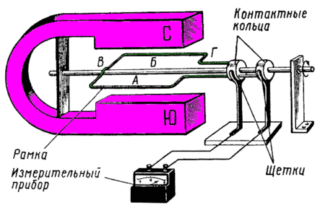
To drain the electric current, the frame is equipped with a current collector, which turns it into a closed loop and ensures constant contact of the rotating frame with the stationary elements of the generator. The spring-loaded brushes are pressed against the collector rings and thus the electric current is supplied to the output terminals of the generator.
Rotating, the halves of the frame successively pass near the poles of the magnet. In this case, a cyclical change in the direction of movement of the emerging current occurs - at each pole, the current moves in one direction.
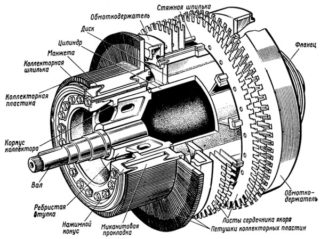
Depending on the design of the collector, the generator can produce both direct and alternating current.
- In DC generators, for each half of the winding in the collector assembly, there are half rings isolated from each other. Due to the fact that these half rings are constantly changing with brushes, the current does not change its direction, but simply pulsates.
- In alternators, the ends of the frame are tied to slip rings and this whole structure rotates around its axis. When the frame rotates, the brushes, each of which tightly adjoins its own ring, provide a reliable down conductor. In this case, there is no cyclical change in the position of the brushes.
The rotating part of the generator is called the rotor, and the stationary part is called the stator.
The principle of operation of alternating and direct current generators is identical. They differ from each other in the design of the slip rings located on the rotating rotor and the configuration of the windings.
In alternators, an original technical solution is often used, based on the fact that EMF occurs in a conductor not only when it rotates in a magnetic field, but also when the magnetic field itself rotates relative to a stationary conductor.
This effect is widely used by developers who place electric or permanent magnets on a rotating rotor. In this case, the voltage is removed from the stationary installed winding, which makes it possible to get rid of complex designs of current-collecting units.
Alternating current generators
- constructive performance;
- method of excitement;
- number of phases.
According to the method of excitation, the consumer may encounter units:
- with independent excitation - the excitation winding is powered by direct current from an independent power source;
- with self-excitation - a rectified current from the generator itself is supplied to the excitation winding;
- with excitation from permanent magnets - there is no excitation winding;
- with excitation from an exciter - a low-power DC generator, "sitting" on the same shaft with the generator being serviced.
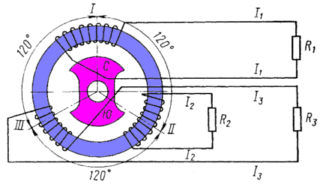
By the number of phases, electric generators are:
- single phase;
- biphasic;
- three-phase.
In practice, three-phase alternators are most common. This is due to a number of advantages characteristic of this type of aggregates:
- obtaining an economic effect in the development of systems for the transmission of electricity over long distances - reducing the material consumption of transformer devices and power wires; This is facilitated by the presence of a circular magnetic field;
- increased service life, which ensures the balance of the system;
- simultaneous use of line and phase voltage.
Structurally, a three-phase electric generator has three independent windings located in the stator in a circle with an offset of 120 ° relative to each other. In this case, each winding is a single-phase generator, which is capable of supplying an alternating voltage to the consumer R. Such a single winding is called "phase". Phase windings can be interconnected by "delta" or "star".
There are other schemes for connecting the windings, for example, the six-wire Tesla system or the Slavyanka connection (a combination of six windings in the form of one "star" and one "triangle"), but they were not widely used.
The role of the frame in devices that generate alternating current is played by an electromagnet, which, while rotating, displaces the alternating EMF induced in the windings by a third of a cycle relative to each other.
Among the many alternators, there are two main types of their design: synchronous and asynchronous. Recently, given the large number of complex electronic devices controlled by microprocessors, a new type of electric generator has appeared - inverter.
Synchronous power generators
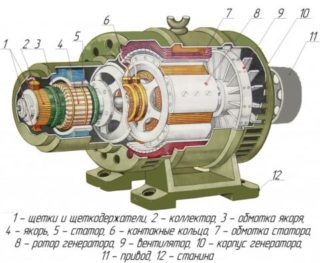
A synchronous alternator is structurally composed of two parts - a movable rotor and a fixed stator.
When the rotor rotates, which is an electromagnet with a core and an excitation winding, connected to an external power source using a brush mechanism, an EMF is induced in the stator winding, which is fed to the output terminals of the generator. This design eliminates the need for sliding contacts, which greatly simplifies the design of the unit. Initially, the magnetic flux is excited from a third-party exciter attached to a common shaft and connected to the system using a coupling.
In low-power synchronous electric generators, the excitation winding is powered by rectified current. In this case, the electrical circuit is formed due to the activation of the transformers included in the load circuit. A semiconductor rectifier is also included there. The main electrical circuit includes:
- excitation winding;
- adjusting rheostat.
The main feature of a synchronous generator is that the frequency of the generated electric current is proportional to the rotor speed.
Asynchronous power generators
The design of asynchronous generators is simple, but at the same time it has the worst technical characteristics in comparison with synchronous units - the error in frequency can reach 4%, and in terms of voltage - up to 10%. In addition, asynchronous generators are critical to the amount of starting current. Therefore, it is recommended to operate them in conjunction with stabilizers, and in some cases, for example, for a soft start of an electric motor, a frequency converter may be needed.
Inverter generators
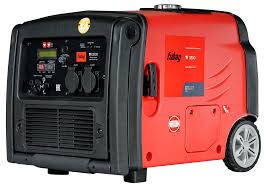
An inverter electric generator is a conventional asynchronous generator, at the output of which an additional stabilizer of output parameters is installed.
It works as follows: the voltage generated by the asynchronous generator enters the inverter, where it is first rectified, and then pulses of a given frequency and duty cycle are formed from the obtained constant voltage. At the output of the device, these pulses are converted into a sinusoidal voltage with almost ideal technical characteristics.
Alternator drive
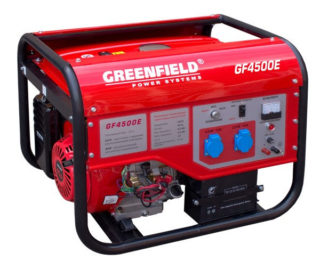
In a domestic environment, the generator rotor is driven by internal combustion engines (ICEs) that run on fuels such as gasoline or diesel. At the same time, the service life of gasoline generators equipped with two-stroke internal combustion engines is about 500 hours per year (no more than 4 hours per day); four-stroke ICE reaches 5000 hours per year.
It is advisable to use gasoline generators for short power outages and / or for going out into the countryside.
Diesel generators are more powerful and more durable than gasoline generators. Among them there are models with air and liquid cooling. Air-cooled units are recommended for use in places where electricity is often cut off for a long time.
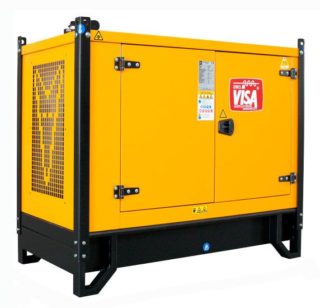
Using such household devices is extremely simple - you need to fill in fuel into the tank, turn the key to start the engine and connect the load. Their control panel is provided with all the necessary and intuitive labels and symbols.
Liquid-cooled diesel power generators are devices of a completely different category. They are capable of working day and night and are used mainly in enterprises as sources of backup power.
Industrial generators, designed to generate alternating current and supply it to consumers over long distances using high-voltage power lines (PTL), operate by activating hydraulic or steam turbines. In such units, the rotor mechanism is connected directly to the turbine wheel.
Turbine power generators are characterized by high power (up to 100,000 kW) and are capable of generating alternating current with voltage up to 16 kV. In this case, the length and diameter of their rotor can reach 6.5 and 15 meters, respectively, and the rotation speed of the latter is in the range of 1500 ... 3000 rpm. Such units are installed in separate rooms on specially prepared concrete bases.
Household generator options and capabilities
For ease of use, manufacturers equip their products with a number of useful options, among which are:
- device for automatic start of the unit in case of power outage;
- the presence of a built-in RCD that disconnects the device from the mains in case of insulation breakdown and the appearance of a leakage current;
- control of parameters and their display on the display;
- overload protection.
When a load is connected to an electric generator, the value of which will be lower than the rated one, the unit will begin to “eat up” part of the liquid fuel in vain, not fully using its capabilities.
It will not be superfluous to have a special noise-suppressing casing, an enlarged fuel tank, a casing that protects the unit from the effects of low temperatures, etc.
Installation features
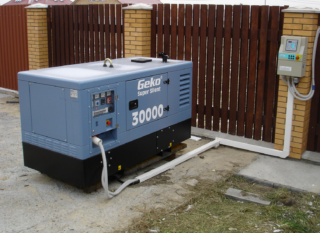
The potential owner of an alternator before purchasing should attend to the preparation of the site for its installation. Regardless of where such a unit will be installed, indoors or outdoors, it will need a flat and solid platform. Installing an electric generator on an uneven ground will increase vibration, which will accelerate the wear of parts and can cause an expensive device to fail.
When installing the generator indoors, it is important to provide for exhaust ventilation. In addition, during the operation of the unit, it is recommended to leave the door of the room open, which in turn will require the installation of a grill in the doorway that blocks outsiders, and most importantly children, access to the danger zone.
Connect the generator to the mains in strict accordance with the requirements set out in the operating instructions. In this case, the electrical cable must be connected after the introductory machine and the electric meter.

